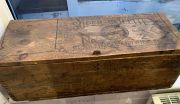of Cannon Street House, London E.C.4.
1820 Company established Sir William Curtis, Bt, a banker, and W. G. Harvey, to exploit a gunpowder works at Hounslow that dated back to the early 18th century or before.
Further works were subsequently acquired, including the Tonbridge Powder Mills in 1859, and those of the Kames's Gunpowder Co in 1886.
1894/5 Started to make and supply cordite to the War Office[1]
1898 Works at Hounslow, Bedfont, North Feltham, Tonbridge
1898 Incorporated as a Limited Company. The company was registered on 24 November, to take over the businesses of certain firms and companies manufacturing black and smokeless military and blasting powders, including Curtis's and Harvey, John Hall and Son, Pigou, Wilks and Laurence. [2]. It already included Kames's Gunpowder Co; others which were included in the new combination were Hay, Merricks and Co, Ballincollig Royal Gunpowder Mills Co, Midlothian Gunpowder Co, Kennall Gunpowder Co, East Cornwall Gunpowder Co[3]
1907 Started to manufacture gas mantles, with a factory at Dartford; it soon becoming the largest manufacturer in England.
1914 Explosives Manufacturers. Specialities: "Smokeless Diamond" and "Amberite" Smokeless Sporting Powders, "Diamond Grain" Black Sporting Powder; "Ironclad" Patent Metal Top Incandescent Gas Mantles and "Dreadnought", "Iris", "Evening Star" etc. Gas Mantles; Dynamite, Gelignite etc.; Blasting Powders for Coal Mines, Ironstone, Granite and Slate Quarries; "Cheddite" and Winter Gelignite which will not freeze; Special Permitted Explosives for use in fiery mines; Military Powders, Cordite and Black Powders of all descriptions; Accessories such as Safety Fuse, Detonator Fuses, Firing Cables, Exploders, Warming Pans etc. [4]
1918 Incorporated into Explosives Trades Ltd as part of the merger of 29 makers of explosives[5]
1920 Recognising that the production of gas mantles had become more than a sideline, a new subsidiary was established Record Gas Mantle Co Ltd which acquired the Ironclad mantle activity[6].
1930 ICI, which had a controlling interest in Lighting Trades, purchased the remaining shares for cash[7].
1932 Incorporated in the new ICI (Explosives) [8].
See Also
Sources of Information
- Archives of the British chemical industry, 1750-1914: a handlist. By Peter J. T. Morris and Colin A. Russell. Edited by John Graham Smith. 1988











